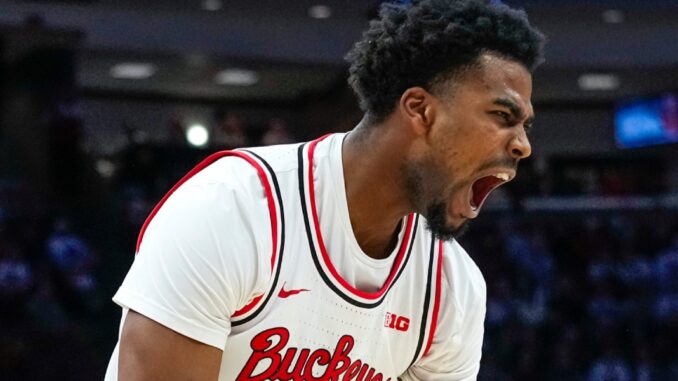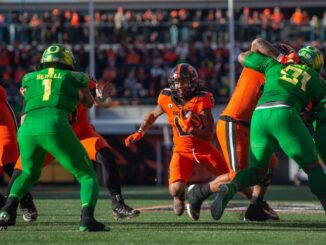
If recent years have taught us anything, it’s that the transfer portal rarely delivers without a catch. But in the case of Sean Stewart, the Oregon Ducks have not just landed a high upside player; they have gotten a blue-chip talent with the potential to redefine their frontcourt identity fully.
Stewart’s freshman year at Duke offered glimpses of potential, but limited minutes left him looking for a bigger stage elsewhere. The young prodigy was also keen on joining a team that would allow him to be himself and, in the process, be able to help the team achieve new heights.
What he found at Eugene was not just an opportunity; it was a basketball ecosystem that thrives on positional versatility and player development. These are the two main things Sean Stewart craved at this juncture in his basketball career.
Now, Stewart is officially a Duck; the question now shifts from why he left and what he brings, to how his presence could tilt the Ducks’ trajectory heading into the 2025 season.
From Blue Blood to Green and Yellow
Stewart’s numbers at Duke (2.6 points per game and 3.2 rebounds per game) don’t stand out on paper. But just as it’s the case in many other instances, numbers don’t usually tell the full story. Stewart was a victim of Duke’s rotation logjam, buried behind a highly experienced frontcourt talent and a system that did not allow him to stretch out his wings fully. Still, flashes of his potential were evident: the instinctual shot-blocking, pogo-stick bounce, and the motor that does not simply shut off.
In high school, Stewart was ranked as a 5-star recruit and McDonald’s All-American, praised for his defensive versatility, athleticism, and nose for the ball. Stewart’s commitment to Duke did feel like a natural step for a player with the aspirations to one day play in the NBA.
After transferring from Duke, he played the 2024–25 season at Ohio State, starting 30 of 32 games for the Buckeyes. As a 6-foot-9 sophomore forward, he averaged 5.7 points, 5.8 rebounds, and 0.9 blocks per game while shooting an efficient 54.2% from the field. He ranked second on the team in rebounds and led in blocks, showcasing his athleticism and defensive versatility. However, foul trouble was an issue—he averaged 3.4 fouls per game and fouled out of seven contests, which at times limited his effectiveness. Still, his per-40-minute numbers—12.5 rebounds and 2 blocks—underscored his impact as a high-motor rebounder and interior defender.
By switching to Oregon, Stewart now gets something more valuable than prestige. The young point forward gets a system in place that needs him to be himself and not just a cog in someone else’s machine.
A Seamless Fit: Stewart’s Game and Altman’s System Were Made for Each Other
Dana Altman’s teams are typically built on defensive flexibility and up-tempo play. The seasoned coach doesn’t pigeonhole players into static roles, but instead lets his players explore. This is an ideal landing spot for someone like Stewart, a 6’9 forward with elite athleticism and a wingspan that turns passing lanes into traps.
Altman has a track record of maximizing long, bouncy forwards. Think Jordan Bell. Think Chris Boucher. Whether unlocking their untapped potential or tailoring his system to their strengths, Altman has consistently turned raw tools into refined production, making Oregon an ideal landing spot for players like Sean Stewart.
While Stewart brings similar raw tools, his main selling point is that he comes with a slightly higher ceiling as an offensive creator. That being said, Oregon does not just need frontcourt muscle; they need someone who can protect the rim, switch positions, and eventually stretch the floor. Stewart may not be fully there yet, but he will have the minutes, reps, and leash to get there in Eugene.
The Stewart Effect: Early Contributions You Can Count On
Even without a fully polished offensive skill set, Stewart is Oregon’s most explosive athlete immediately. His second-jump timing and vertical pop give him an edge on both the defensive and offensive ends. That athleticism allows Sean to thrive in the gaps, doing the dirty work, making hustle plays, and shifting momentum without needing the ball in his hands.
Sean doesn’t need touches to impact the game, he’ll adjust shots, run the floor and provide momentum-swinging putbacks that will have both the crowd and the team on their feet. On the defensive end, Stewart’s game comes to life. His lateral movement allows him to switch onto guards and wings easily, and his recovery speed often means that very few mistakes would go uncorrected. From what we’ve already seen in the past, Altman has never shied away from throwing his forwards into the fire defensively, and Stewart seems wired for this type of challenge.
Despite being a force to reckon with on the defensive end, Sean Stewart would need to work on his offensive spacing and decision-making. Stewart is not a shooter, and while his handles are featured, they are not functional. When it’s all said and done, the Ducks don’t need Stewart to put up 20 points in every game. They need consistency, energy, and someone who can anchor their frontcourt, which has lacked a true disruptor since the departure of Wooten.
How Sean Stewart’s Arrival Reshapes the Duck’s Future
In the short term, the arrival of Sean Stewart brings stability to a frontcourt that has undergone significant change. But more than that, it signals a philosophical shift. Oregon did not just land a former 5-star to fill a depth chart gap; they targeted someone who would fit their identity and raise their ceiling.
Stewart’s commitment to the team may serve as a recurring signal for a program that has flirted with national relevance but has not yet fully recaptured the magic of its Final Four run in 2017. By landing Sean Stewart, the Ducks have proven they can still attract elite talent from high school and college blue bloods. That matters in the transfer portal era, where optics and opportunity are intertwined.
Scouts, fans, and Altman will closely monitor Stewart’s overall development. But it’s also fair to say that the Ducks boast one of the most intriguing forward prospects in the Big Ten. If the jump from Durham to Duck territory goes as planned, Oregon won’t just be a tough out in the conference play, they will be a team with postseason aspirations and a legitimate frontcourt to anchor and build around.
Long-Term Upside: More Than Just a Rental
There is a real chance that Stewart could be one-and-done. Not in the traditional freshman sense, but in the “prove it” transfer mold, which has become extremely common in today’s basketball landscape. However, Oregon might offer a compelling reason for Stewart to stay with the team for another year, especially if the developmental trajectory is upward.
If Stewart thrives in Eugene, showing scouts that he can guard multiple positions, hit the occasional mid-range jumper, and clean up the boards with more purpose, his stock will rise. But if the Ducks can convince Stewart to commit to a second year, the payoff could be greater for both sides. Oregon would rather have a potential All-Big Ten cornerstone, and Stewart would continue to mature in a system that fully understands how to maximize his strengths.
Conclusion
That being said, there’s no guarantee in college basketball anymore, not with NIL, the Portal, and the constant churn of rosters. But some moves tend to feel like they are going to work. Sean Stewart to Oregon happens to be just one of them.
Sean Stewart is not arriving with gaudy stats or a surefire NBA projection. What he brings to Eugene instead is hunger, humility, and a high ceiling. For a Ducks team looking to reestablish its defensive identity and athletic edge, those qualities matter now more than ever.
Stewart did not just transfer for minutes, he moved for meaning. And if all goes well, his time in Eugene could be the stretch where promise finally meets production.



